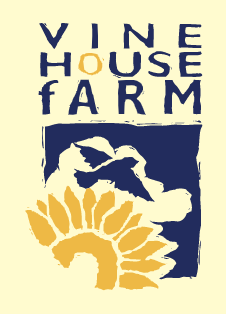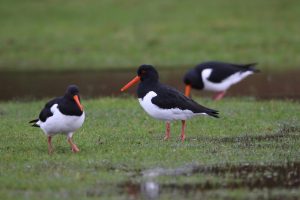
October has been a wretched month here at Vine House Farm, cold and wet, 92mm/3.6ins of rain and the coldest October for 20 years, overall average of 9.8°C.

October 2019 was a nightmare of a month and this year was just about the same, rain on every day except for seven days. The only difference between them was that in 2019 we’d had a wet June, July, August and September. Fortunately this year, September was quite a dry month.
The soil has been getting wetter and wetter through the month, making every job more difficult. Only half of our wheat drilling has been completed, but we are nearly there with the potatoes, just two more days left. Yields of potatoes on nearly every field and every other grower that we talk to are down, probably because of the wet conditions last winter. The soil was not in good condition when potatoes were planted in the Spring as every field was so wet when ploughed last Autumn. However, in September and the first half of October, the fields were ploughing really well, the roots of the crops this summer have done a wonderful job in repairing the soil.
We grow chipping potatoes for McCain’s and one of their customers is MacDonald’s who like a particular variety of potatoes which we grow called Russet Burbank. Every year, we get invited to an end of season barbecue to thank us for growing potatoes, where they give a cup to the grower who has performed the best for them over the past season. It didn’t take place this July, for obvious reasons, but we have just been informed that we were one of their top ten growers, out of more than 200, and we will be receiving a challenge cup. The credit of course has to go to my son-in-law Robert and the staff, for producing the potatoes and who quite often had to come to work at short notice and at weekends, when McCain’s found themselves short of potatoes.
Although we have been growing oil seed rape every year, it has been an unprofitable crop for the last two years. This is because of the cabbage stem flea beetle, in some cases eating the whole crop. We threatened not to grow it this year and some growers haven’t grown any, but we have and fortunately the dreaded beetle has not been around. The beetle is only 2mm long, so think how many there could be per acre, or per 100 acres, as some fields are that large – our largest one is 60 acres. There were chemicals to control the beetle, but it had become resistant to them all, except neonicotinoids which of course have been withdrawn, so we don’t have any chemical means of controlling them.
Instead we have sown buckwheat with our rape, which is a nurse crop. We hope the buckwheat confuses the flea beetle and it won’t find the rape plants. It grows very quickly and then gets killed off by a frost. By then, hopefully the rape will be past the susceptible stage.
With only seven dry days in October, there were just two days, 19th and 20th, when it was possible to harvest the sunflowers. They harvested well and are now drying on the floor dryer.
The quinoa is now dry and ready to go to Long Sutton to be dressed and cleaned. It is a very small seed and we do not have the machinery to make it 100% quinoa. We will then be having some to sell in the Farm Shop.


Our resident birds have been on lockdown, as they usually are at this time of year. By that I mean they are moulting, eating plenty and keeping out of harms way. All our summer migrants have gone south, except a few Stone Curlews. They have gone south because they have run out of food, their food being insects, which disappear as Summer goes and Autumn comes.
Over the last 50 years, Stone Curlews have struck lucky. Their traditional habitat of light sandy land can be found in the Brecks, the Hampshire and Wiltshire downs, where there are large outdoor pig farms. As Stone Curlews feed on soil invertebrates, these outdoor pig farms massively increase the number of soil invertebrates, which are then available to them all the year round. Having a surplus of food makes some of them reluctant to make their migration to West Africa.
Fieldfares and Redwings have now been arriving in quite large numbers for the past two weeks. Most of them have not stopped to eat our Hawthorn berries, they have kept going South West, maybe to the apple orchards of the West Country. Birds are very good at remembering food sources, as they spend 75% of their waking life looking for food.
Apart from Redwings and Fieldfares, there are tens of thousands of birds streaming across the North Sea. Just in our parish this last week, we have had 20,000 Starlings, 2,000 Lapwings and 1,000 Golden Plovers. Admittedly, we are in a big parish, but if that is replicated up and down the country, millions of those three species must be arriving. Then, there are Teal, Wigeon, Chaffinches, Bramblings, Blackbirds, Goldcrests, Robins, Woodcock, Wood Pigeons and Snipe to name just the commoner birds. Quite a lot will carry on going south west, many Snipe for instance end up in Morocco. They are all coming south and west to get away from snow and ice.
All these birds need insects in the first few weeks of their life and in general, the population density where they have been coming from does not impact on the countryside, like it does in the UK. So most of the birds have a better future than those breeding in the UK. However, there is concern worldwide about insects as they are declining.
In contrast, there are Geese who, as well as their goslings, thrive on short grass and we are a nation of grass cutters. Overall the population of Grey Geese, the Pink Foots, the Grey Lags, Canadas, Barnacles and the European Whitefronts has increased tenfold in the last 80 years. They all stream south from their breeding grounds in September and October, many of them providing spectacles for us to see in various parts of the country. The Greenland White Fronted Goose is not doing very well however, as where they go to breed in western Greenland, they must compete with the Canada Geese which migrate from the USA. The Canada Goose is our largest goose, they have done very well in the USA and they also breed in western Greenland. They have pushed the White Fronted Geese into the hills, onto unsuitable breeding grounds.
Some Blackbirds have come back into the Vine House Farm garden, mainly because we have planted Pyracantha bushes over the past few years. Berries are a great food source for several species, so we have been planting Mahonia Cotoneaster and Mountain Ash as well, to make sure we have berries for most of the year. Tree Sparrows continue to feed on red millet and the House Sparrows have taken to it now.
Barn Owls have not fared well this summer, rearing on average about half a chick per pair. This doesn’t sound good, however it isn’t as bad as 2015, when not one chick was raised in Deeping Fen. They must be finding adequate food at the moment, as we are not seeing them flying in daylight hours.



